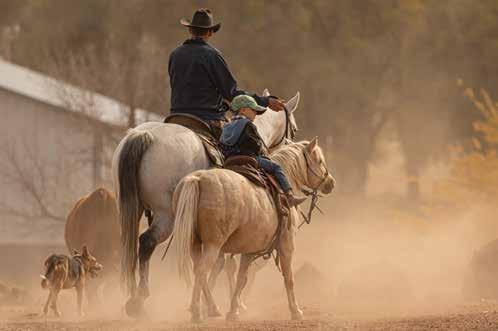
2 minute read
The Importance of Colostrum
by Mark Z. Johnson, Oklahoma State University Extension as published on BeefMagazine.com
Being ready and prepared before the start of calving season can make life much easier for cow-calf producers and potentially save a calf. By the time calving season starts, you need everything on hand that might be necessary and all equipment and facilities in working order. Operators should have several doses of colostrum or colostrum replacer on inventory before the start of calving season.
Adequate colostrum intake is extremely crucial for newborn calves in order to gain passive immunity. Calves born after a prolonged delivery through the pelvic canal can suffer from severe respiratory acidosis. Such calves are less efficient at absorbing colostral immunoglobulins or antibodies even if artificially fed colostrum. The only disease protection baby calves will receive is from the passive transfer of antibodies from the colostrum they ingest. Colostrum also contains transferrin and lactoferrin, which bind iron and restrict bacterial growth. These factors, together with immunoglobulins, help limit growth of bacteria in the gut.
Colostrum or colostrum replacer will need to be administered by bottle suckling or tube feeding within a few hours of birth for maximal absorption of immunoglobulins. The general rule of thumb is the sooner colostrum is ingested the better and calves will typically stand, walk and nurse within one hour after birth. Bottomline: if there is any question of if a calf has received adequate colostrum, then colostrum should be administered immediately to the newborn. Calves that miss getting timely colostrum ingestion are much more likely to suffer from calf scours, which can have lifelong effects on general hardiness and disease resistance.
Previously obtained colostrum must be kept frozen to protect the integrity of the large protein molecules that make up the various immunoglobu- lins. Fresh colostrum can be stored in one-quart doses by putting that much in a gallon-size Ziploc bag. Lay the bags flat to freeze in the freezer. When the time comes to thaw the colostrum body weight within the first six hours and repeat the feeding when the calf is about 12 hours old. For an 80-pound calf, this will equate to about 2 quarts of colostrum per feeding. and feed it to the newborn calf, the “best practice” is to thaw in a warm water bath at 122 degrees Fahrenheit for one hour. Avoid thawing at room temperature or in a microwave oven.
Adequate and timely colostrum prevents nutritional deficiencies causing weak calf syndrome, from which calves often die within a few days of birth.
The amount of immunoglobulin ingested is a major factor in final blood immunoglobulin concentration and disease protection. A practical rule-ofthumb is to feed 5% to 6% of the calf’s
Commercial colostrum replacers contain more than 100 grams of immunoglobulin per dose. Always read the label before purchasing. It is important not to confuse supplements and replacers. Supplements are used to boost antibody protection a calf gets from nursing and contain 40 to 60 grams of immunoglobulins, which is not enough to provide protection in a calf that has not nursed. //
We practice selection and culling for traits that support efficiency and longevity within our environmental constraints of the Badlands in North Dakota. Cattle that excel in this setting can flourish just about anywhere else!


Annual Producti Sale
Wednesday, March 8, 2023
The Feedlot • Belfield, ND
Lunch 11:30 a.m. MT • Sale 1 p.m. MT
Tuesday, March 7 • The Feedlot
Prime Rib Supper • 6 p.m.
Selling:
45 Red Angus Yearling Bulls
70 Angus Yearling Bulls
10 Angus 2-Year-Old Bulls
Including a good selection of heifer-bull prospects.
Registered & Commercial Red Angus Heifers Available by Private Treaty
Buy with c fidence –
Our bulls are genomic tested, parent verified, carcass ultrasounded and fertility tested.








